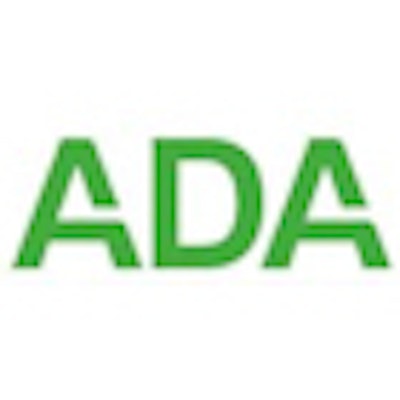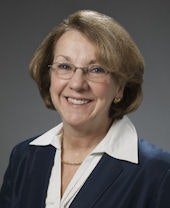
I have heard there will be changes to the ADA Library. What are those changes, and when will they take effect? Full library services as a public "walk-in" library will continue through 2012. However, in 2013, the ADA will transition to a private-use library with a scope of services that were deemed most valuable by ADA members.
 |
| Kathleen O'Loughlin, DMD, MPH, executive director of the ADA. |
For instance, the ADA is determining what digital services can be offered or enhanced to meet growing technological preferences while serving a greater geographic region of members. Data indicate that less than 1% of the ADA's 157,000 members used the library's services in 2011. Each member that physically entered the library in 2012 came at a cost of $1,000 per use. ADA members simply can't afford to see year-over-year dues increases due to the ADA not managing its assets carefully, with an eye toward effectiveness and efficiency, as well as the future needs of our newest members of the profession who access everything electronically.
We are not eliminating the library's services; rather, changing the manner in which these valuable services are delivered. The world is moving to digital, and so must the ADA. The ADA is still determining the manner in which core services will be offered. Last year this included funding for the Cochrane Library. Electronic collections and digital services will be increased to stay current with evolving technology, and the ADA must keep up with these technological trends in order to have the strongest possible value for our members. Access to journal articles will continue in the same manner as they are available now.
Recognizing how unique the collection is, the ADA is working to find a partner to physically house these materials and is exploring potential partnership(s) with regional medical libraries. The ADA values its long, successful history, but we also are a forward-looking organization and that means some changes are necessary to continue to be a leader in dentistry. Library collections and physical space will be maintained through 2012. Changes will be implemented after a full transition plan is finalized, sometime after October 2013.
A changing world
Why are these changes necessary? The ADA, like many other nonprofit and for-profit organizations, has had to face rising expenses and declining revenues and member market share. The relevance of the ADA to new members of our profession is at risk. We gain new net members every year, but far less than the ADA needs to in order to keep up with the growth of the dental profession.
For the last few years the ADA's expenses have surpassed revenue. Without changes, this would have again been the case in 2013. That is why the ADA Board had to carefully consider all ADA programs and services, apply universal criteria in order to evaluate them against one another, compare their alignment to the current ADA strategic plan, and then make difficult funding decisions.
These tough but important decisions are helping turn the tide after several years of financial instability and member market share erosion. We must build a unique and powerful value to all members, in a cost-effective way that best meets their needs, if organized dentistry is to survive well into the future.
How did the Board of Trustees and House of Delegates come to this decision? The previous budgeting process was driven line item by line item. The ADA lacked a method of comparing all programs across the association to measure the return on investment or the objective of building member value. Line-by-line budget eliminations here and there allowed for some immediate gains in financial efficiencies. However, this approach lacked focus as to how the programs related to the ADA strategic plan, including the achievement of measurable results.
For the first time, the 2013 budget was presented to the board in a single list of prioritized programs across the ADA, based on a set of universal assessment criteria. This list made clear what was highly ranked and thus highly valued by members, as well as what was lower ranked and of lower value. In addition, each program was presented with associated revenues and costs that included estimates of staff time required.
This new budget report format became the platform for a more thoughtful allocation of resources better aligned with the ADA's long-term strategic plan goals. Decision lens is the Web-based application that was used to automate the pair-wise comparison process that involved hundreds of volunteers. It is only a tool. The decision to change the library business model was based on multiple inputs, including data, the prudent judgment of well-informed volunteer leaders, and the need to create a stronger, more relevant ADA.
Surplus budget needed
Some have asked, since a surplus is budgeted for 2013, why not use those funds for the library? A surplus is necessary in order to build the ADA reserve fund. For any organization to operate in a financially stable and sustainable method, reserves are necessary. We also need to invest in our buildings, and until 2013 the ADA didn't have a fund for that.
Many programs throughout the association require funding to continue and succeed; unfortunately, it was necessary to make difficult choices. The library is not the only area where investments were scaled back. The ADA simply does not have unlimited resources to continue to fund every program and project at the current levels while achieving a balanced budget. Tough decisions, based on data and objective criteria, had to be made. Careful consideration was given in order to determine what was most valued by members, and also to ensure alignment of each program to the ADA's strategic plan. Through this process, the association was able to continue to fund those programs that were highly ranked.
Will there still be library staff to provide customer service to members? The library has long been known for providing outstanding customer service to ADA members, and this will not change. At this time, we are still determining what changes in staffing may be necessary. The ADA Library will maintain a number of qualified staff to assist members in finding the information they need through the good customer service they have come to know and expect. For example, we will still have a trained archivist on staff to assist in searching our rich historical archives.
The Board of Trustees and House of Delegates do not make staffing decisions. Rather, these groups determine the budget for the association. Then the executive director, human resources, and those divisions determine how those funds will be used for the programs and staffing. No budget decisions are made lightly.
Is it possible that the board and/or house will reverse the decision? The decision on the library was a fair and democratic process, the same in which all ADA resolutions are considered at the House of Delegates. Reference committee hearings provide individuals and organizations the opportunity for discourse, which is then considered by the reference committee executive committee in order to prepare a report to the House of Delegates. A further opportunity for discourse is provided on the floor of the house itself prior to voting by the delegates.
In this case, the ADA House of Delegates has called for a transition plan for the library to be developed and reported back to them in October 2013. Once the report that contains the transition plan is developed, the Board of Trustees, which is the managing body for the association, will have the opportunity to see it. The board may discuss the report and submit comments on it to be transmitted to the House of Delegates. This is not a decision that was made lightly. Likewise, great discussion and consideration will be given to the transition plan. A work group will be created to help develop the transition plan, and then the board will review and further discuss.
Do the changes to the ADA library signify a trend? Just as the magazines and newspapers are changing to meet the demand for digital content, so too must the ADA. This is a trend; and we must keep with the time to stay relevant and impactful. There is a growing trend from medical and other associations for online catalogs in place of hard-copy materials. In fact, the Northwestern Medical School is currently in the process of transferring materials to an offsite location. Other associations offer library use only for its employees, such as the American Medical Association.

















